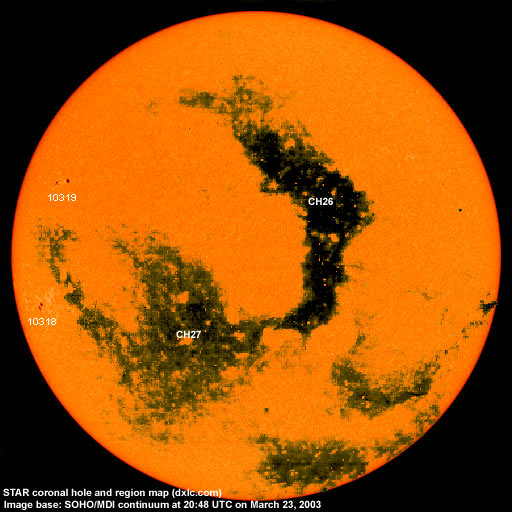

Last update issued on March 24, 2003 at 03:55 UTC.
[Solar and geomagnetic data - last 4 weeks (updated daily)]
[Solar wind and electron fluence charts (updated daily)]
[Solar cycles 21-23 (last update March 3, 2003)]
[Solar cycles 1-20]
[Graphical comparison of cycles 21, 22 and 23 (last update March 3, 2003)]
[Graphical comparison of cycles 10, 13, 17, 20 and 23 (last update March 3, 2003)]
[Historical solar and geomagnetic data charts 1954-2002 (last update January 27, 2003)]
[Archived reports (last update March 17, 2003)]
The geomagnetic field was quiet to major storm on March 23. Solar wind speed ranged between 565 and 713 km/sec under the influence of a high speed coronal hole stream.
Solar flux measured at 20h UTC on 2.8 GHz was 93.0. The planetary A
index was 24 (STAR Ap - based on the mean of three hour interval ap indices: 23.6).
Three hour interval K indices: 42464332 (planetary), 42453332 (Boulder).
The background x-ray flux is at the class B1-B2 level.
At midnight there were 2 spotted regions on the visible disk. Solar flare activity was low. A total of 2 C class events was recorded during the day. A C1.1 flare at 19:10 UTC had its origin in a region which is about to rotate into view at the northeast limb.
Region 10318 developed slowly and quietly. Flare: A long duration C1.9 event peaking
at 12:14 UTC.
New region 10319 emerged in the northeast quadrant.
March 21-23: No obviously geoeffective CMEs observed.
Coronal hole history (since late October 2002)
Compare today's report with the situation one solar rotation ago: 28
days ago 27 days ago 26
days ago
A well placed, developing and recurrent coronal hole (CH26) mainly in the northern hemisphere was in a geoeffective position on March 22-23. A coronal hole (CH27) in the southern hemisphere will rotate into a geoeffective position on March 24-25.

Processed SOHO EIT 284 image at 01:06 UTC on March 24. Any black areas on the solar disk are likely coronal holes.
The geomagnetic field is expected to be quiet to active on March 24 due to a high speed stream, then unsettled to minor storm from late on March 24 until March 26 due to a high speed stream from coronal hole CH26. Quiet to active is likely on March 27-29 due to another high speed stream, this time from CH27. Long distance medium wave (AM) band propagation along east-west paths over high and upper middle latitudes is very poor, propagation along north-south paths is fair. [Trans Atlantic propagation conditions are currently monitored every night on 1470 kHz. Dominant station tonight: none, several stations noted including Radio Cristal del Uruguay, Cadena Peruana and Radio Vibración (Venezuela)]
| Coronal holes (1) | Coronal mass ejections (2) | M and X class flares (3) |
1) Effects from a coronal hole could reach Earth within the next 5 days.
2) Material from a CME is likely to impact Earth within 96 hours.
3) There is a possibility of either M or X class flares within the next 48 hours.
Green: 0-20% probability, Yellow: 20-60% probability, Red: 60-100% probability.

Compare to the previous day's image.
Data for all numbered solar regions according to the Solar Region Summary provided by SEC/NOAA. Comments are my own, as is the STAR spot count (spots observed at or inside a few hours before midnight) and data for regions not numbered by SEC or where SEC has observed no spots.
| Solar region | Date numbered | SEC spot count |
STAR spot count |
Location at midnight | Area | Classification | Comment |
|---|---|---|---|---|---|---|---|
| 10316 | 2003.03.18 | 2 | S11W02 | 0010 | CRO | now spotless | |
| 10317 | 2003.03.20 | N04W38 | plage | ||||
| 10318 | 2003.03.22 | 6 | 3 | S15E62 | 0070 | CAO |
area was 0040 at midnight |
| 10319 | 2003.03.23 | 5 | 3 | N13E53 | 0030 | CAO |
classification was DAO at midnight, area 0040 |
| Total spot count: | 13 | 6 | |||||
| SSN: | 43 | 26 | |||||
| Month | Average solar flux at Earth |
International sunspot number | Smoothed sunspot number |
|---|---|---|---|
| 2000.04 | 184.2 | 125.5 | 120.8 cycle 23 sunspot max. |
| 2000.07 | 202.3 | 170.1 | 119.8 |
| 2001.12 | 235.1 | 132.2 | 114.6 (-0.9) |
| 2002.02 | 205.0 | 107.4 | 114.6 (+1.2) |
| 2002.03 | 179.5 | 98.4 | 113.3 (-1.3) |
| 2002.04 | 189.8 | 120.7 | 110.5 (-2.9) |
| 2002.05 | 178.4 | 120.8 | 108.8 (-1.7) |
| 2002.06 | 148.7 | 88.3 | 106.2 (-2.6) |
| 2002.07 | 173.5 | 99.6 | 102.7 (-3.5) |
| 2002.08 | 183.6 | 116.4 | 98.7 (-4.0) |
| 2002.09 | 175.8 | 109.6 | (94.7 predicted, -4.0) |
| 2002.10 | 167.0 | 97.5 | (91.2 predicted, -3.5) |
| 2002.11 | 168.7 | 95.0 | (86.0 predicted, -5.2) |
| 2002.12 | 157.2 | 81.6 | (81.6 predicted, -4.4) |
| 2003.01 | 144.0 | 79.5 | (78.6 predicted, -3.0) |
| 2003.02 | 124.5 | 46.2 | (73.6 predicted, -5.0) |
| 2003.03 | 130.1 (1) | 83.5 (2) | (67.9 predicted, -5.7) |
1) Running average based on the daily 20:00 UTC observed solar flux value at 2800 MHz.
2) Unofficial, accumulated value based on the Boulder (SEC/NOAA) sunspot number. The official international sunspot number is typically 25-45% less.
This report has been prepared by Jan Alvestad. It is based partly on my own observations and interpretations, and partly on data from sources noted in solar links. All time references are to the UTC day. Comments and suggestions are always welcome.
| [DX-Listeners' Club] |